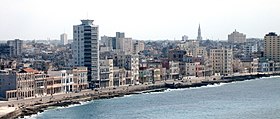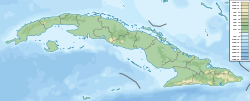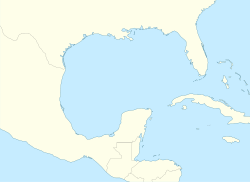
Back Havana ACE Havana Afrikaans Havanna ALS ሀቫና Amharic L'Habana AN Hafana ANG هافانا Arabic هاڤانا ARZ L'Habana AST La Habana AVK
This article may be too long to read and navigate comfortably. (July 2023) |
Havana
La Habana | |
|---|---|
Capital city and province | |
| Municipio de La Habana | |
From the top to the left: Línea Street; Barrio chino; Malecón; Palacio de la Revolución; and Castillo del Morro | |
|
| |
| Nickname: City of Columns[1] | |
| Coordinates: 23°08′12″N 82°21′32″W / 23.13667°N 82.35889°W | |
| Country | Cuba |
| Metro Zone | Greater Havana |
| Established | November 16, 1519 (current place) |
| Municipalities | 15 |
| Government | |
| • Body | Gobierno Provincial de La Habana |
| • Governor | Reynaldo García Zapata (PCC) |
| Area | |
| • Total | 728.26 km2 (281.18 sq mi) |
| Elevation | 59 m (195 ft) |
| Population | |
| • Total | 2,130,872 [2] |
| • Rank | 7th in North America 1st in Cuba |
| • Density | 2,926/km2 (7,580/sq mi) |
| Demonym | Habaneros-habaneras |
| GDP (PPP, constant 2015 values) | |
| • Year | 2023 |
| • Total | $41.1 billion[3] |
| • Per capita | $19,100 |
| Time zone | UTC−5 (UTC−05:00) |
| • Summer (DST) | UTC−4 (UTC−04:00) |
| Postal code | 10xxx–19xxx |
| Area code | (+53) 07 |
| ISO 3166 code | CU-03 |
| Patron saint | San Cristóbal |
| HDI (2019) | 0.834[4] – very high |
| Website | www |
| Official name | Old Havana and its Fortification System |
| Type | Cultural |
| Criteria | iv, v |
| Designated | 1982 (6th session) |
| Reference no. | 204 |
| Region | Latin America and the Caribbean |
Havana (/həˈvænə/; Spanish: La Habana [la aˈβana] ⓘ; Lucumi: Ilú Pupu Ilé)[5] is the capital and largest city of Cuba. The heart of the La Habana Province, Havana is the country's main port and commercial center.[6] It is the most populous city, the largest by area, and the second largest metropolitan area in the Caribbean region. The population in 2002 was 2,137,847 inhabitants,[7][6] and its area is 728.26 km2 (281.18 sq mi)[2] for the capital city side and 8,475.57 km2 for the metropolitan zone.[7][8]
Havana was founded by the Spanish in the 16th century. It served as a springboard for the Spanish conquest of the Americas, becoming a stopping point for Spanish galleons returning to Spain. Philip II of Spain granted Havana the title of capital in 1607.[9] Walls and forts were built to protect the city.[10]
The city is the seat of the Cuban government and various ministries, and headquarters of businesses and over 100 diplomatic offices.[11] The governor is Reinaldo García Zapata of the Communist Party of Cuba (PCC).[12][13] In 2009, the city/province had the third-highest income in the country.[14]
Contemporary Havana can essentially be described as three cities in one: Old Havana, Vedado and the newer suburban districts.[15] The city extends mostly westward and southward from the bay, which is entered through a narrow inlet and which divides into three main harbors: Marimelena, Guanabacoa and Antares. The Almendares River traverses the city from south to north, entering the Straits of Florida a few miles west of the bay.[16]
The city attracts over a million tourists annually;[17] (1,176,627 international tourists in 2010,[17] a 20% increase from 2005). Old Havana was declared a UNESCO World Heritage Site in 1982.[18] The city is also noted for its history, culture, architecture and monuments.[19] As typical of Cuba, Havana experiences a tropical climate.[20]
- ^ "How Obama's US-Cuba deal could shape Havana's future". Lonely Planet. Archived from the original on January 10, 2015. Retrieved January 10, 2015.
- ^ a b "Demographic Yearbook of Cuba 2021/Anuario Demografico de Cuba 2021 (in Spanish)" (PDF). Archived from the original (PDF) on November 18, 2022. Retrieved August 4, 2022.
- ^ "TelluBase—Cuba Fact Sheet" (PDF). Tellusant. Retrieved January 11, 2024.
- ^ "Subnational Human Development Index". Global Data Lab. Retrieved June 16, 2020.
- ^ Cabrera, Lydia (April 1, 2019). Anagó: vocabulario lucumí: El yoruba que se habla en Cuba (in Spanish). Linkgua. ISBN 978-84-9007-834-1.
- ^ a b Cuba. The World Factbook. Central Intelligence Agency.
- ^ a b "Población total por color de la piel según provincias y municipios" (PDF). 2012 Official Census. Oficina Nacional de Estadística e Información. Archived from the original (PDF) on November 10, 2013.
- ^ "Largest Cities in the Caribbean".
- ^ "Havana". The Free Dictionary.
capital of Spanish Cuba in 1552
- ^ "Old Havana". www.galenfrysinger.com.
- ^ "Cuba – Embassies and Consulates". Embassypages.com. Archived from the original on October 4, 2018.
- ^ San Miguel, Raúl (January 18, 2020). "Electos el Gobernador y Vicegobernadora en La Habana". Tribuna de La Habana (in Spanish).
- ^ (in Spanish) [1] Archived January 22, 2020, at the Wayback Machine Preside Esteban Lazo toma de posesión de las autoridades de Gobierno en La Habana
- ^ "Workforce and Salary (Section 4.5)" (in Spanish and English). Oficina Nacional de Estadisticas – Republica de Cuba. Archived from the original on December 16, 2010.
- ^ Cite error: The named reference
:2was invoked but never defined (see the help page). - ^ "Anuario Estadistico de Ciudad de La Habana" (in Spanish). ONE – Oficina Nacional de Estadisticas (National Statistics Office). Archived from the original on August 4, 2011. Retrieved November 28, 2011.
- ^ a b "Section 15 (Turismo), article 15.7 (Visitantes por mes)" (in Spanish). ONE- Oficina de Estadisticas de Cuba. Archived from the original on August 4, 2011. Retrieved November 28, 2011.
- ^ "Old Havana and its Fortification System". UNESCO World Heritage Centre. UNESCO.ORG.
- ^ Goodsell, James Nelson (April 11, 2017). "Havana". Encyclopædia Britannica.
- ^ "Havana climate summary". Weatherbase. Retrieved March 23, 2016.
© MMXXIII Rich X Search. We shall prevail. All rights reserved. Rich X Search









